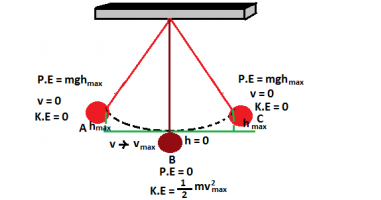NCERT Solutions of Class 9 Science Chapter 11 – Work and Energy
Complete NCERT solutions of Class 9 science NCERT textbook chapter 11-Work and Energy are explained here for your help in the forthcoming examination, class tests, and in your science assignments. The NCERT solutions of class 9 science are of the questions asked between the pages of chapter 11-Work and Energy and in the back exercise at the end of the chapter. Class 9 Science NCERT Solutions of chapter 11- Work and Energy are the inputs for triggering your science knowledge to the concept of physics.

The NCERT solutions of chapter 11-Work and Energy will help you in clearing your concept about the working functions of machines and tools. The class 9 science NCERT solutions of chapter 11 are not only for helping class 9 students, the NCERT solutions of the chapter Work and Energy are also useful for clearing the fundamentals required for the preparations of entrance exams of engineering, NDA and CDS. Here all NCERT solutions of chapter 11-Work and Energy are solved by a science expert teacher as per the CBSE norms. At the end of the chapter don’t forget to write your comment so that we could refine our study material as per your requirement.
Here you can study NCERT Solutions of all the chapters of class 9 science free of cost, you can download the pdf of chapter-wise solutions of class 9 science NCERT unsolved questions. Along with NCERT Solutions of class 9 science, you can study solutions of previous year’s question papers, sample papers, important questions, and other class 9 science notes free of cost.
Click for online shopping
Future Study Point.Deal: Cloths, Laptops, Computers, Mobiles, Shoes etc
NCERT Solutions of the chapter 11-Work and Energy
You can download PDF-NCERT solutions of class 9 science chapter 11- Work and Energy
PDF-NCERT Solutions of the chapter 11-Work and Energy
Q1. A force of 7 N acts on an object. The displacement is, say 8m. in the direction of the force. Let us take it that the force acts on the object through the displacement. What is the work done in this case?
Ans. Force (F) = 7 N, displacement (d) = 8 m
Work done (W) = F × d
= 7N × 8m
= 56 NM
= 56 J
Q2. When do we say that work is done?
Ans.When the direction of the force on an object and the displacement in it on the same direction then we can say that work is done on the object.
Q3. Write an expression for the work done when a force is acting on an object in the direction of its displacement.
Ans. Let the work done = W and a force acting on it is = F
The displacement on the object = d
Then, W = F × d
Q4. Define 1 J of work.
Ans. Let the force (F) = 1 N, d = 1 m
W = 1 N × 1 m
W = 1 Nm
W = 1 J
So, 1 J of work is done if an object is displaced to 1m by a 1N
newton force.
Q5. A pair of bullocks exerts a force of 140 N on a plough. The field being ploughed is 15 m long . How much work is done in ploughing the length of the field.
Ans. The force F = 140 N, displacement d = 15 m
The work is done,W = F x d
W = 140 x 15
W = 2100 J
Q6. What is the kinetic energy of an object?
Ans. The efficiency of doing work by a moving object is known as its kinetic energy. As an example a moving car, waterfall, bullet fired by a gun, etc.
Q7. Write an expression for the kinetic energy of an object.
Ans.
m → mass of the
moving body, v → velocity of the body.
Q8. The kinetic energy of an object of mass, m moving with the velocity of 5 m/s is 25 J. What will be its kinetic energy when its velocity is increased three times?
Ans.
Velocity of the object, v = 5m/s
25 =( 1/2 ) ×m ×5²
m =2 kg
If the velocity of the object = 3 × 5 = 15 m/s then its K.E = will become
The kinetic energy of the object is 225 J when velocity increased three times.
Q9. What is power?
Ans. The rate of doing work is power.
P = W/t, W → work is done, t → time taken in work done
Unit of power = joule/second = watt
Q10. Define 1 watt of power.
Ans. Work was done on an object, W= 1 J, time t = 1 s
Then the power P = W/t = 1 J/1 s
= 1 J/s
= 1 watt
So, 1 J of work done in 1 s then the power consumption is equal to 1 watt or we can say when the rate of energy consumption is 1 J/s then power is 1 watt.
Q11.A lamp consumes 1000 J of electrical energy in 10 s. What is its power?
Ans. The power is the rate of doing work or rate of energy consumption
So, P = E/t
P = 1000 J/10 s = 100 watt
Q12.Define average power.
Ans. Let W1 work is done in time interval t1 and W2 work done in time interval t2, then the average power Pav
Average power = Total work done or total energy consumed/total time taken
Average power = (W1 + W2 )/(t1 + t2 )
So, the average power is obtained by dividing the total energy consumed by the total time taken.
Q13.Look at the activities listed below. Reason out whether or not work is done in the light of your understanding of the term ‘work’.
- Suma is swimming in a pond.
- A donkey is carrying a load on its back.
- A windmill is lifting water from a well.
- A green plant is carrying out photosynthesis.
- An engine is pulling a train.
- Food grains are getting dried in the sun.
- A sailboat is moving due to wind energy.
Ans.
- Suma is applying the force by his hand in pushing the
water in backward direction in turn of this she is getting
an equal opposite force which is making him to move
forward, so work is done here. - In this case, the donkey is carrying a load but it is applying a
force in upward direction means perpendicular to the
displacement which is in the forward direction so work
done on the load by donkey is zero. - In this case, a windmill is lifting water means there is a
the force applied by the windmill in displacing the water
from the well, so here is work done by the windmill. - During photosynthesis leaves are not moving, the
displacement is 0 so the work done is 0. - An engine is applying the force on the train and the train is
moving in the direction of the force. So in this casework
is done by the engine because force and displacement
are in the same direction. - Foodgrains are not moving so work is not done because
displacement is 0. - Wind energy is applying a force on the boat which is
moving forward in the direction of the force so work is
done by the wind energy because of both displacements
and the force is in the same direction.
Q14. An object was thrown at a certain angle to the ground moves in a curved path and falls back to the ground. The initial and the final points of the path of the object lie on the same horizontal line. What is the force of the work done by the force of gravity on the object?
Ana. The work is done by the object W = F × d
F = mg, and displacement = h ─ h = 0( initial and final points areon the same horizontal plane)
W = mg × (h ─ h)
W = mg × 0
W = 0
So the work done by the force of gravity on the object is = 0 joule.
Q15. A battery lights a bulb. Describe the energy changes involved in the process.
Ans.A battery lights a bulb by changing its chemical energy into electrical energy and then bulb changes electrical energy into light energy and heat energy. During this process following transformation takes place.
Chemical energy →electrical energy→light energy + heat energy
Q16.The certain force acting on a 20 kg mass changes its velocity from 5m/S to 2m/s. Calculate the work done by the force.
Ans. Work is done by the object = energy transferred
As we know the energy of moving object=
Initial velocity, u = 5 m/s
Final velocity, v = 2m/s
So, work done = Final energy – initial energy
=40 – 250
= -210
So, work done by the force acting on the object is = ─ 210 J, the negative the sign shows that the direction of the force is opposite to the direction of motion.
Q17. A mass of 10 kg is at a point A on a table. It is moved to a point B. If the line joining A and B is horizontal, the hat is the work done on the object by the gravitational force? Explain your answer.
Ans. The direction of gravitational force acting on the object is in the downward direction =mg = 10 x 9.8 = 98 N
It is moved to point B on the same horizontal plane. The direction of displacement on the object and the gravitational force on it are perpendicular to each other means there is no displacement in the direction of a gravitational force so work done by the gravitational force is = 0 joule.
Q18. The potential energy of a freely falling object decreases progressively. Does this violate the law of conservation of energy? Why?
Ans. The potential energy of a freely falling object decreases but its velocity increases due to the gravitational acceleration of the earth so it’s kinetic energy increases as it reaches nearer to the surface of the earth. It follows the conservation of law because of the sum of the kinetic energy and potential energy remains always constant in the journey of the object.
Q19.What are the various energy transformations that occur when you are riding a bicycle?
Ans. When we are riding a bicycle our muscular energy transformed into heat energy and kinetic energy of the bicycle which moves the bicycle. The energy transformation occurs as follows.
![]()
Q20.Does the transfer of energy take place when you push a huge rock with all your might and fail to move it?
Ans. When we push a huge rock with all our might and fail to move. In this case, energy is not transformed but the muscular energy transformed into heat energy which increases the heat of our body.
Q21. A certain household has consumed 250 units of energy during a month. How much energy is this in joules.
Ans. 1 unit = 1 kilowatt hour
Q22.An object of mass 40 kg is raised to a height of 5m above the ground. What is its potential energy? If the object is allowed to fall, find its kinetic energy when it is halfway down.
Ans.The potential energy of the object = mgh
m = 40 kg, h = 5m, g = 9.8 m/s²
When it is allowed to fall, then u =0
velocity in the halfway down = v and height of the object in the halfway = h/2 = 5/2
applying the third equation of the motion
The direction of motion of the object is in the direction of gravity, so v = 7
Therefore the kinetic energy of the object at halfway down is = 980 joule
Q23.What is the work done by the force of the gravity on a satellite moving round the earth? Justify your answer.
Ans. The direction of the force of gravity on a satellite moving around the earth is perpendicular to the direction of displacement, So the work done on the satellite by the earth’s gravity is zero.
Q24.Can there be displacement of an object in the absence of any force acting on it? Think. Discuss this question with your friends and teacher.
Ans. The force depends on the acceleration, F = ma, so if acceleration is zero the force becomes zero, so a body that is moving with a uniform velocity will have a net force acting on it equal to zero but have displacement because it is moving.
Q25.A person holds a bundle of hay over his head for 30 minutes and gets tired. Has he done some work or not? Justify your answer.
Ans. The person is applying a muscular force in the upward direction in holding a bundle of hay. In doing this his muscular energy does not transfer to the bundle of hay,it is changed into heat energy which is transferred to the surroundings, there is the consumption of energy so in spite of getting tired there is no work done because net force and displacement on the bundle is zero.
Q26.An electric heater is rated 1500W. How much energy does it use in 10 hours?
Ans.P = 1500 W = 1500/1000 = 1.5 kWh, t = 10 hours
E = P x t
E = 1.5 x 10 = 15 kWh
So, the electric heater will use 15 kWh energy
Q27.Illustrate the law of conservation of energy by discussing the energy changes which occur when we draw pendulum bob to one side and allow it to oscillate. Why does the bob eventually come to rest? What happens to its energy eventually? Is it a violation of the law of conservation of energy?
Ans.

When we allow the bob to move from A it has maximum potential energy =, at this point bob has velocity,v= 0, so its K.E =0. When bob moves to point C, it has max. velocity =
and h =0, so at C it has
Potential energy, P.E =0 and, kinetic energy,
. Once again bob moves to B where it has once again max.displacement i.e and so
and v=0 leads K.E = 0. In the to and fro motion of the bob during each oscillation at every point, the sum of P.E + K.E remains constant and thus follows the rule of conservation of energy. It eventually comes to rest because of
the air resistance. It losses its energy to the surrounding and thus total energy of bob and surrounding remains conserved and hence does not violate the law of conservation of energy.
Q28.An object of mass, m is moving with a constant velocity,v. How much work should be done on the object in order to bring the object to rest?
Ans. In order to bring the moving object in rest, we should have, final
velocity v = 0
The energy of a moving object =
Final energy = 0
The work is done on the object in bringing it up to rest =
Negative sign shows because the direction of force applied for work done is opposite to the direction of motion.
Q29. Calculate the work required to be done to stop a car of 1500kg moving at a velocity of 60 km/h?
Ans. When the car stops its velocity will become ,v = 0
And so final energy =
The energy of the car when it was moving =
The work is done in stopping the car = final energy ─ initial energy
=0 ─ 450000
=─450000 joule
Minus sign indicates that the direction of the force and motion are in
opposite direction.
Q30.In each of the following a force, F is acting on an object of mass, m. The direction of displacement is from west to east shown by the longer arrow. Observe the diagrams carefully and state whether the work done by the force is negative, positive, or zero.

Ans. In the first figure, force, and displacement are perpendicular to each other, So work done will be equal to zero.
In the second fig. the force and displacement are in the same direction, So the work done is positive.
In the third fig.the force and the displacement are in the opposite direction, So work done will be negative.
Q31.Soni says that the acceleration in an object could be zero even when several forces are acting on it. Do you agree with her? Why?
Ans. We agree with Sony, As we know
If , so a = 0, It is clear that if the net force applied on an object is
zero then the acceleration will become zero.
32. Find the energy in kWh consumed in 10 hours by four devises of power 500 W each.
Ans. The sum of powers = 4 ×500W =2000W = 2000/1000 = 2kw
Work done = power ×time( work done= energy consumed)
Energy = P× t
=2kw × 10h
= 20kwh
Q32.A freely falling object eventually stops on reaching the ground. What happens to its kinetic energy?
Ans. When a freely falling object strikes to the ground it’s all potential energy changes into kinetic energy which thereby changed to heat energy and sound energy.
Study notes of Maths and Science NCERT and CBSE from class 9 to 12
Important points: Work and Energy
Work: Work(W) is the product of force(F) and displacement(d) in the direction of the force.
W =F.d
The SI standard of work is the joule
Energy: The efficiency of doing work is known as energy.
The sources of Energy are of different kinds like solar energy, wind energy, thermal energy(i.e heat energy), chemical energy, electrical energy, mechanical energy, etc.
Here in class 9 CBSE you will study mechanical energy
Mechanical Energy: Mechanical energy is the efficiency of doing work by a moving body or when the body is in its specific stationary position. Mechanical energy is of the two kinds.
Work energy theorem: Work and energy are interconverted to each other, work done is stored in the form of energy and transfer of energy lead to be the work done.
∴W = ΔE, where ΔE is the transfer of the energy
1-Potential energy: The efficiency of doing work by a body due to its specific stationary position.
When a object of mass m is displaced by a hight h from the surface of the Earth then
Work done on the object = Force×displacement
W = mg ×h[where mg is force of gravity,m is mass of the object and g is gravitational acceleration)
According to work energy conversion theorem
mgh is the energy transfered to the object is the potential energy(P.E)
P.E =mgh
2-Kinetic energy: The efficiency of doing work by a moving body .
W = F.s ( where F is the force,s is the displacement)
According to the third equation of the motion
v² = u²+2as
s =(v² -u²)/2a
W = F.s =ma.s (m is the mass of the object,a is the acceleration produced on the object)
W =ma.(v² -u²)/2a=m/2(v² -u²)
According to the work(W)-energy(E) theorem
Let the inial velocity of the object is u =0 and under an impact of a force it gains velocity v then its kinatic energy(K.E) is
K.E = 1/2[m(v²-0²)]
K.E = 1/2 mv²
Power: Power(P) is the rate of doing work
The SI unit of energy is the same as that of work done i.e joule
P =W/t, where W is work done, t is the time taken
The SI unit of power is watt
Here Work done can be replaced by the energy E
P = E/t
E = Pt
Energy = Power ×Time
If power is given in hour
Then unit of energy is watt hour
If power is given in hour and power is in kilowatt
Then the unit of energy is kilowatt-hour(kWh), which is the commercial unit of energy
When the power is given in watts and time is given in seconds then the unit of energy is the joule.
The relationship between kWh and joule
1 kWh = 1 kW × 1h
= 1000 W ×(60×60)s
= 1000 W ×(3600)s
=3600000 Ws
1 kWh =36×105joule= 3.6×106joule
CBSE Class 9-Question paper of science 2020 with solutions
CBSE Class 9-Sample paper of science
CBSE Class 9-Unsolved question paper of science 2019
Class 9 CBSE Science Notes
Three Laws of Motion: Class 9 CBSE
Evoporation,Vapourization and Latent heat -Class 9 CBSE notes
What is an atom,molecule and atomicity of a substance?
How to determine Valency,net charge of an ion and Molecular formula of a substance.
Thrust and Pressure : Difference
The Complete Detail of Archimedes Principal
Average Speed and Average Velocity: Differences
How to evaluate recoil velocity of gun
If energy is conserved then why do we need to save it for future generations?
Molar mass,molecular mass and mole concept
What is second law of of motion ?
What is universal law of gravitational force
NCERT Solutions of Science and Maths for Class 9,10,11 and 12
NCERT Solutions for class 9 maths
NCERT Solutions for class 9 science
CBSE Class 9-Question paper of science 2020 with solutions
CBSE Class 9-Sample paper of science
CBSE Class 9-Unsolved question paper of science 2019
NCERT Solutions for class 10 maths
CBSE Class 10-Question paper of maths 2021 with solutions
CBSE Class 10-Half yearly question paper of maths 2020 with solutions
CBSE Class 10 -Question paper of maths 2020 with solutions
CBSE Class 10-Question paper of maths 2019 with solutions
NCERT Solutions for Class 10 Science
Solutions of Class 10 Science Sample Paper and Question Papers for Term-1 and Term 2 2021-22 CBSE Board
Solution of Class 10 Science Question Paper Preboard 2021-22:Term 2 CBSE Board Exam
Solutions of Class 10 Science Sample Paper Term-1 2021-22 CBSE Board
Class 10 Science Sample Paper for Term 2 CBSE Board Exam 2021-22 with Solution
Solutions of Class 10 Science Question Paper Preboard Examination (First) 2021 -22 Class 10 Science
CBSE Class 10 – Question paper of science 2020 with solutions
CBSE class 10 -Sample paper of Science 2020
NCERT Solutions for class 11 maths
| Chapter 1-Sets | Chapter 9-Sequences and Series |
| Chapter 2- Relations and functions | Chapter 10- Straight Lines |
| Chapter 3- Trigonometry | Chapter 11-Conic Sections |
| Chapter 4-Principle of mathematical induction | Chapter 12-Introduction to three Dimensional Geometry |
| Chapter 5-Complex numbers | Chapter 13- Limits and Derivatives |
| Chapter 6- Linear Inequalities | Chapter 14-Mathematical Reasoning |
| Chapter 7- Permutations and Combinations | Chapter 15- Statistics |
| Chapter 8- Binomial Theorem | Chapter 16- Probability |
CBSE Class 11-Question paper of maths 2015
CBSE Class 11 – Second unit test of maths 2021 with solutions
NCERT solutions for class 12 maths
| Chapter 1-Relations and Functions | Chapter 9-Differential Equations |
| Chapter 2-Inverse Trigonometric Functions | Chapter 10-Vector Algebra |
| Chapter 3-Matrices | Chapter 11 – Three Dimensional Geometry |
| Chapter 4-Determinants | Chapter 12-Linear Programming |
| Chapter 5- Continuity and Differentiability | Chapter 13-Probability |
| Chapter 6- Application of Derivation | CBSE Class 12- Question paper of maths 2021 with solutions |
| Chapter 7- Integrals | |
| Chapter 8-Application of Integrals |
Class 12 Solutions of Maths Latest Sample Paper Published by CBSE for 2021-22 Term 2
Class 12 Maths Important Questions-Application of Integrals
Solutions of Class 12 Maths Question Paper of Preboard -2 Exam Term-2 CBSE Board 2021-22
Solutions of class 12 maths question paper 2021 preboard exam CBSE



